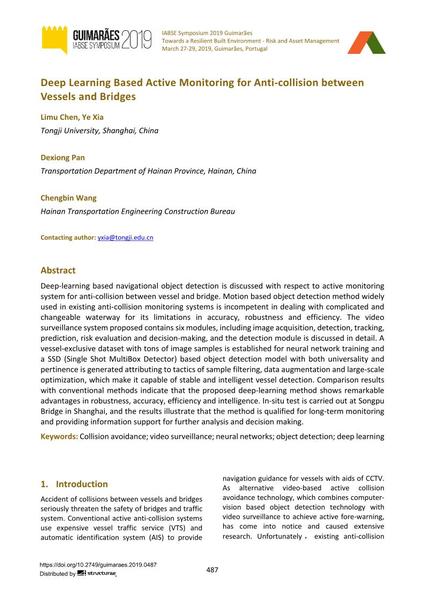Deep Learning Based Active Monitoring for Anti-collision between Vessels and Bridges

|
|
|||||||||||
Bibliographic Details
| Author(s): |
Limu Chen
(Tongji University, Shanghai, China)
Ye Xia (Tongji University, Shanghai, China) Dexiong Pan (Transportation Department of Hainan Province, Hainan, China) Chengbin Wang (Hainan Transportation Engineering Construction Bureau) |
||||
|---|---|---|---|---|---|
| Medium: | conference paper | ||||
| Language(s): | English | ||||
| Conference: | IABSE Symposium: Towards a Resilient Built Environment Risk and Asset Management, Guimarães, Portugal, 27-29 March 2019 | ||||
| Published in: | IABSE Symposium Guimarães 2019 | ||||
|
|||||
| Page(s): | 487-491 | ||||
| Total no. of pages: | 5 | ||||
| DOI: | 10.2749/guimaraes.2019.0487 | ||||
| Abstract: |
Deep-learning based navigational object detection is discussed with respect to active monitoring system for anti-collision between vessel and bridge. Motion based object detection method widely used in existing anti-collision monitoring systems is incompetent in dealing with complicated and changeable waterway for its limitations in accuracy, robustness and efficiency. The video surveillance system proposed contains six modules, including image acquisition, detection, tracking, prediction, risk evaluation and decision-making, and the detection module is discussed in detail. A vessel-exclusive dataset with tons of image samples is established for neural network training and a SSD (Single Shot MultiBox Detector) based object detection model with both universality and pertinence is generated attributing to tactics of sample filtering, data augmentation and large-scale optimization, which make it capable of stable and intelligent vessel detection. Comparison results with conventional methods indicate that the proposed deep-learning method shows remarkable advantages in robustness, accuracy, efficiency and intelligence. In-situ test is carried out at Songpu Bridge in Shanghai, and the results illustrate that the method is qualified for long-term monitoring and providing information support for further analysis and decision making. |
||||
| Keywords: |
deep learning Collision avoidance video surveillance neural networks object detection
|
||||
